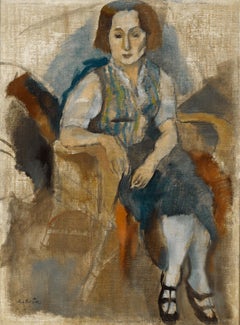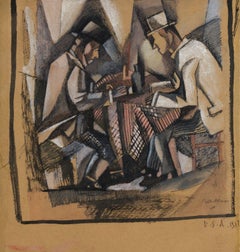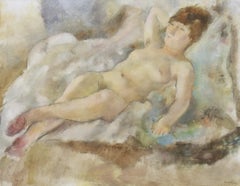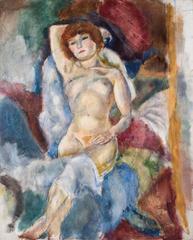Jules Pascin Paintings
to
3
2
2
3
2
3
2
Overall Height
to
Overall Width
to
1
1
1
1
5
4
4
2
2
1
1
5
1
1
1
22
870
658
647
610
4
2
2
2
2
Artist: Jules Pascin
Femme aux Souliers Noir (Woman in Black Shoes)
By Jules Pascin
Located in New Orleans, LA
This intimate portrait was composed by the Bulgarian-born French Expressionist painter Jules Pascin. Known as the "Prince of Montparnasse," Pascin made a name for himself throughout ...
Category
Early 20th Century Modern Jules Pascin Paintings
Materials
Oil, Canvas
Les buveurs
By Jules Pascin
Located in London, GB
Jules Pascin was a larger-than-life artist who defied easy categorisation. The Bulgarian-born, Viennese-trained artist moved to Paris in 1905 and quickly fell into influential circle...
Category
1910s Jules Pascin Paintings
Materials
Ink, Pen, Gouache, Watercolor, Paper
Gouache Painting Jules Pascin Hand Signed Woman in Boudoir German Expressionism
By Jules Pascin
Located in Surfside, FL
Genre: German Expressionist
Subject: Woman
Medium: gouache paint
Surface: Paper board
This is hand signed lower right.
Framed it measures 17.25 X 15.5, sheet 12 X 10
This came from a Jewish estate. there was no additional paperwork or provenance.
Julius Mordecai Pincas (March 31, 1885 – June 5, 1930), known as Pascin Jules...
Category
Early 20th Century Expressionist Jules Pascin Paintings
Materials
Paper, Cardboard, Gouache
Rebecca Couchée by JULES PASCIN - School of Paris, Nude Painting, Figurative Art
By Jules Pascin
Located in London, GB
*UK BUYERS WILL PAY AN ADDITIONAL 5% IMPORT DUTY ON TOP OF THE ABOVE PRICE
Rebecca Couchée by JULES PASCIN (1885-1930)
Oil over pencil on canvas
73.1 x 91.8 cm (28 ¾ x 36 ⅛ inches)
Signed lower right, Pascin
Executed in 1927, Boulevard de Clichy, Paris
Provenance
Collection Marcel Bernheim, Palais des Beaux-Arts de Bruxelles, acquired from the artist, 1928
Pierre Blum, Paris, acquired from the above, 1952
Perls Galleries, New York, no. 13565
Private collection, Osaka
Sotheby’s, New York, 14th May 1998
Peter Findlay Gallery Inc., New York
Private collection, USA, acquired from the above, June 2011
Literature
Luis Seoane...
Category
1920s Post-Impressionist Jules Pascin Paintings
Materials
Oil, Canvas, Pencil
A Group of Prostitutes
By Jules Pascin
Located in London, GB
JULES PASCIN 1885-1930
Vidin, Bulgaria 1885-1930 Paris ( Bulgarian / French / American)
Title: A Group of Prostitutes
Technique:Original Hand Signed Sanguine Crayon Drawing on Chi...
Category
1970s Impressionist Jules Pascin Paintings
Materials
Crayon
Related Items
The Abduction of the Sabine Women , a Renaissance drawing by Biagio Pupini
Located in PARIS, FR
This vigorous drawing has long been attributed to Polidoro da Caravaggio: The Abduction of the Sabine Women is one of the scenes that Polidoro depicted between 1525 and 1527 on the façade of the Milesi Palazzo in Rome. However, the proximity to another drawing inspired by this same façade, kept at the Ecole des Beaux-Arts, and to other drawings inspired by Polidoro kept at the Musée du Louvre, leads us to propose an attribution to Biagio Pupini, a Bolognese artist whose life remains barely known, despite the abundant number of drawings attributed to him.
1. Biagio Pupini, a Bolognese artist in the light of the Roman Renaissance
The early life of Biagio Pupini, an important figure of the first half of the Cinquecento in Bologna - Vasari mentions him several times - is still poorly known. Neither his date of birth (probably around 1490-1495) nor his training are known. He is said to have been a pupil of Francesco Francia (1450 - 1517) and his name appears for the first time in 1511 in a contract with the painter Bagnacavallo (c. 1484 - 1542) for the frescoes of a church in Faenza. He then collaborated with Girolamo da Carpi, at San Michele in Bosco and at the villa of Belriguardo.
He must have gone to Rome for the first time with Bagnacavallo between 1511 and 1519. There he discovered the art of Raphael, with whom he might have worked, and that of Polidoro da Caravaggio. This first visit, and those that followed, were the occasion for an intense study of ancient and modern art, as illustrated by his abundant graphic production.
Polidoro da Caravaggio had a particular influence on the technique adopted by Pupini. Executed on coloured paper, his drawings generally combine pen, brown ink and wash with abundant highlights of white gouache, as in the drawing presented here.
2. The Abduction of the Sabine Women
Our drawing is an adaptation of a fresco painted between 1525 and 1527 by Polidoro da Caravaggio on the façade of the Milesi Palace in Rome. These painted façades were very famous from the moment they were painted and inspired many artists during their stay in Rome. These frescoes are now very deteriorated and difficult to see, as the palace is in a rather narrow street.
The episode of the abduction of the Sabine women (which appears in the centre of the photo above) is a historical theme that goes back to the origins of Rome and is recounted both by Titus Livius (Ab Urbe condita I,13), by Ovid (Fasti III, 199-228) and by Plutarch (II, Romulus 14-19). After killing his twin brother Romus, Romulus populates the city of Rome by opening it up to refugees and brigands and finds himself with an excess of men. Because of their reputation, none of the inhabitants of the neighbouring cities want to give them their daughters in marriage. The Romans then decide to invite their Sabine neighbours to a great feast during which they slaughter the Sabines and kidnap their daughters.
The engraving made by Giovanni Battista Gallestruzzi (1618 - 1677) around 1656-1658 gives us a good understanding of the Polidoro fresco, allowing us to see how Biagio Pupini reworked the scene to extract this dynamic group.
With a remarkable economy of means, Biagio Pupini takes over the left-hand side of the fresco and depicts in a very dense space two main groups, each consisting of a Roman and a Sabine, completed by a group of three soldiers in the background (which seems to differ quite significantly from Polidoro's composition).
The balance of the drawing is based on a very strongly structured composition. The drawing is organised around a median vertical axis, which runs along both the elbow of the kidnapped Sabine on the left and the foot of her captor, and the two main diagonals, reinforced by four secondary diagonals. This diamond-shaped structure creates an extremely dynamic space, in which centripetal movements (the legs of the Sabine on the right, the arm of the soldier on the back at the top right) and centrifugal movements (the arm of the kidnapper on the left and the legs of the Sabine he is carrying away, the arm of the Sabine on the right) oppose each other, giving the drawing the appearance of a whirlpool around a central point of support situated slightly to the left of the navel of the kidnapper on the right.
3. Polidoro da Caravaggio, and the decorations of Roman palaces
Polidoro da Caravaggio was a paradoxical artist who entered Raphael's (1483 - 1520) workshop at a very young age, when he oversaw the Lodges in the Vatican. Most of his Roman work, which was the peak of his career, has disappeared, as he specialised in facade painting, and yet these paintings, which are eminently visible in urban spaces, have influenced generations of artists who copied them abundantly during their visits to Rome.
Polidoro Caldara was born in Caravaggio around 1495-1500 (the birthplace of Michelangelo Merisi, known as Caravaggio, who was born there in 1571), some forty kilometres east of Milan. According to Vasari, he arrived as a mason on the Vatican's construction site and joined Raphael's workshop around 1517 (at the age of eighteen according to Vasari). This integration would have allowed Polidoro to work not only on the frescoes of the Lodges, but also on some of the frescoes of the Chambers, as well as on the flat of Cardinal Bibiena in the Vatican.
After Raphael's death in 1520, Polidoro worked first with Perin del Vaga before joining forces with Maturino of Florence (1490 - 1528), whom he had also known in Raphael's workshop. Together they specialised in the painting of palace façades. They were to produce some forty façades decorated with grisaille paintings imitating antique bas-reliefs.
The Sack of Rome in 1527, during which his friend Maturino was killed, led Polidoro to flee first to Naples (where he had already stayed in 1523), then to Messina. It was while he was preparing his return to the peninsula that he was murdered by one of his assistants, Tonno Calabrese, in 1543.
In his Vite, Vasari celebrated Polidoro as the greatest façade decorator of his time, noting that "there is no flat, palace, garden or villa in Rome that does not contain a work by Polidoro". Polidoro's facade decorations, most of which have disappeared as they were displayed in the open air, constitute the most important lost chapter of Roman art of the Cinquecento. The few surviving drawings of the painter can, however, give an idea of the original appearance of his murals and show that he was an artist of remarkable and highly original genius.
4. The façade of the Milesi Palace
Giovanni Antonio Milesi, who commissioned this palace, located not far from the Tiber, north of Piazza Navona, was a native of the Bergamo area, like Polidoro, with whom he maintained close friendly ties. Executed in the last years before the Sack of Rome, around 1526-1527, the decoration of Palazzo Milesi is considered Polidoro's greatest decorative success.
An engraving by Ernesto Maccari made at the end of the nineteenth century allows us to understand the general balance of this façade, which was still well preserved at the time. The frescoes were not entirely monochrome, but alternated elements in chiaroscuro simulating marble bas-reliefs and those in ochre simulating bronze and gold vases...
Category
16th Century Old Masters Jules Pascin Paintings
Materials
Ink, Gouache, Pen
Young Swimmer (Modern, Academic Style Portrait Painting in Antique Gold Frame)
By Mark Beard
Located in Hudson, NY
Figurative oil on canvas painting of a young athletic male
24 x 20 inches, 29.5 x 23.5 inches vintage gold painted wood frame
signed B. Sargeant in red in upper right hand corner
T...
Category
21st Century and Contemporary Modern Jules Pascin Paintings
Materials
Canvas, Oil
H 29.5 in W 23.5 in D 1 in
Nude oil painting, large post-impressionist sitting nude by Pio Santini
Located in AIGNAN, FR
Large vintage nude portrait oil painting of a woman sitting. This is a gorgeous, colourful and exceptional nude oil painting by Pio Santini, signed in the lower right. A young woman...
Category
1940s Post-Impressionist Jules Pascin Paintings
Materials
Oil
"Somewhere in Paris" Oil Painting
By Suchitra Bhosle
Located in Denver, CO
Suchitra Bhosle's "Somewhere in Paris" is an original, hand made oil painting that depicts a feminine model in a translucent white shift reclining on a background of white.
About th...
Category
2010s Post-Impressionist Jules Pascin Paintings
Materials
Board, Oil
The Night Passeth, the Day Cometh - British Post Impressionist art oil painting
By Harry Morley
Located in London, GB
This superb British exhibited Post Impressionist oil painting is by much sought after noted artist Harry Morley. It was painted in 1921 and exhibited that year at the Royal Academy L...
Category
1920s Post-Impressionist Jules Pascin Paintings
Materials
Oil
The Cyclists Rest Stop in Honfleur
Located in London, GB
'The Cyclists Rest Stop in Honfleur' by Jean-Marie Luc Blanpain, oil on canvas (circa 1970s). The artist's depiction of the terrace of the well known Honfleur restaurant, 'Au Relais ...
Category
1970s Modern Jules Pascin Paintings
Materials
Canvas, Oil
Playing around- 21st Century Contemporary Portrait of a woman
Located in Nuenen, Noord Brabant
Alejandro Casanova
Playing around
100 x 100 cm
oil on canvas
The Spanish artist Alejandro Casanova lives and works in Tenerife, where he moved afte...
Category
2010s Contemporary Jules Pascin Paintings
Materials
Canvas, Oil
Free Shipping
H 39.38 in W 39.38 in D 1.97 in
Nude woman oil on canvas painting
Located in Barcelona, Barcelona
María Rosa Arsalaguet (1922-2003) - Female nude - Oil on canvas
Oil measures 86x65 cm.
Frameless.
painter. He specialized in religious themes, still lifes and flowers.
He participa...
Category
1960s Post-Modern Jules Pascin Paintings
Materials
Oil, Canvas
The South of France Coastal Sea View Large 1970's French Impressionist Pastel
Located in Cirencester, Gloucestershire
French Landscape
by Josine Vignon (French 1922-2022) ...
Category
1970s Impressionist Jules Pascin Paintings
Materials
Pastel, Wax Crayon
Storm clouds over head, Original painting, Horse Racing Art, Animal, sports art
By Garth Bayley
Located in Deddington, GB
An original painting by Garth Bayley. Pen, watercolour and ink painting of the horses racing on a stormy day.
ADDITIONAL INFORMATION:
Storm clouds over head by Garth Bayley [2020]
...
Category
2010s Contemporary Jules Pascin Paintings
Materials
Paper, Watercolor, Ink, Pen
H 17.72 in W 25.2 in D 0.04 in
Modernist Nude Portrait by Henri Burkhard
By Henri Burkhard
Located in Larchmont, NY
Henri Burkhard, Born in New York in 1892, began his studies at the Art Students league in New York and then pursued international studies at the Académie Julian, Acadêmie Colarissi, and Académie de la Grande Chaumière, Pariss.
Once the artist returned to New York, he began to exhibit frequently frequently at the Whitney Museum of American Art in 1926-36; the Corcoran Gallery, Art Institute of Chicago, and the Pennsylvania Academy of Fine Arts in the 1930's. Works by the artist have been handled and sold over the last hundred years at major American auction houses and dealers, such as Heritage...
Category
1930s Fauvist Jules Pascin Paintings
Materials
Oil, Wood Panel
French School - PS 233 La Fauve s'habille en Leopard Oil Post Impressionist
Located in Zofingen, AG
Ps 233 La Fauve S'habille en leopard. (Tawny wears leopard)
Portrait of a naked woman who is carrying a leopard.
Structural analysis:
Closeup portrait of a naked woman. The backgro...
Category
2010s Impressionist Jules Pascin Paintings
Materials
Canvas, Ink, Oil, Acrylic
H 27.56 in W 19.69 in D 1.5 in
Previously Available Items
Nu, le Bras Levé
By Jules Pascin
Located in London, GB
Oil and pencil on canvas
72.4 x 59.1 cm (28 ½ x 23 ¼ inches)
Signed upper right, Pascin
Executed 1916
Literature
Jules Pascin: Catalogue Raisonné by Krohg, Hemin, Perls and R...
Category
Early 20th Century Expressionist Jules Pascin Paintings
Materials
Oil, Pencil
Jules Pascin paintings for sale on 1stDibs.
Find a wide variety of authentic Jules Pascin paintings available for sale on 1stDibs. You can also browse by medium to find art by Jules Pascin in paint, canvas, fabric and more. Much of the original work by this artist or collective was created during the 20th century and is mostly associated with the Post-Impressionist style. Not every interior allows for large Jules Pascin paintings, so small editions measuring 16 inches across are available. Customers who are interested in this artist might also find the work of Georges Rouault, Louis Valtat, and Charles Picart le Doux. Jules Pascin paintings prices can differ depending upon medium, time period and other attributes. On 1stDibs, the price for these items starts at $4,200 and tops out at $98,500, while the average work can sell for $59,705.







